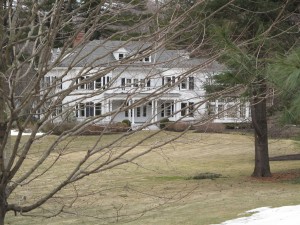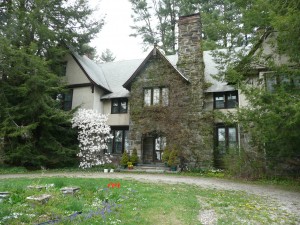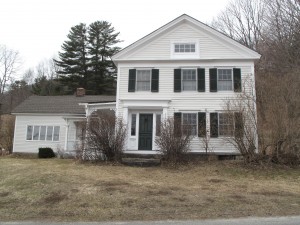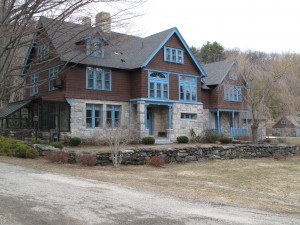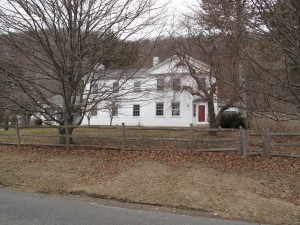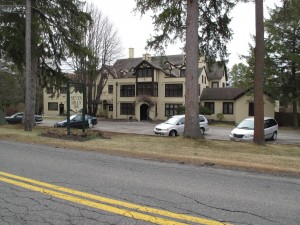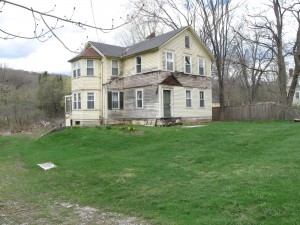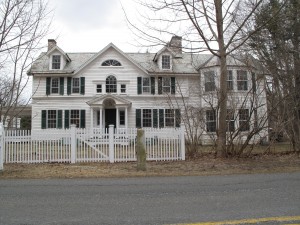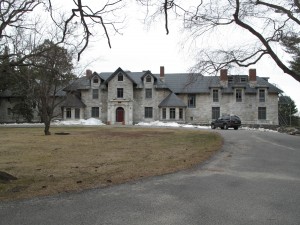
From Surveys Completed 2011-2012 by the Lenox Historical Commission
ARCHITECTURAL DESCRIPTION:
This stone edifice is designed in the style of an English Manor, but with eclectic architectural elements. The house is two stories in height, has a hipped roof with slate shingles, and seven bays on its symmetrically organized front facade. In addition there are 3-bay wings on each side, with hipped roofs. There are seven brick chimneys, two of which are on the front wall of the right wing. One-story turrets are near the outer edges of the main section. The center entrance pavilion has a front gable roof having exposed rafter ends. The entrance door surround is marble with a Roman- or round-arched opening, a broken pediment, two engaged Doric columns and flanking pilasters. Other architectural features of the building are more Gothic in style, with peaked windows and steeply pitched broken-eave dormers. The left wing is deeper than the right and has a much more recent 1-story, gable roofed, rear extension off of it. There are some intact pairs of 6-light metal-framed casement windows with 4-light transoms, but a good number of the windows have been replaced. The foundation is stone. A wide terrace is located behind the house extending between the outer wings.
A small 1-story octagonal garden building with dressed marble walls and copper clad dome is located southeast of the house. It has dentils at its cornice and bas-relief panels in a vase and floral design are above the wall openings. It has lost its original garden setting to newer surrounding facilities. Behind this structure is a wood-framed dormitory, built c.1970, with concrete block first floor and vertical T-1-11-type siding on the second. It has a hipped roof. A c.1950 wood-framed garage with front gable roof and wood novelty siding is sited directly east of the house. Its single-car vehicle bay has been in-filled with a door and flanking windows. Marble piers flank the entry to a long driveway off West Street that curves back a circular drive centered on the front entrance to the house. This circular section has a low stone wall encircling it. A driveway branches off the long drive northeast of the house to provide access to the rear portions of the property, which includes outdoor tennis and basketball courts. A stone wall runs along the front property line/West Street right-of-way from the marble entry piers.
Architects Carrere and Hastings
John Merven Carrère was born in Rio de Janeiro, Brazil, the son of John Merven Carrère, a Baltimore native and Anna Louisa Maxwell, a Scots/Brazilian native of Rio who was the daughter of Joseph Maxwell, a prosperous coffee trader. The architect’s father entered Maxwell’s coffee business and later developed other business interests of his own in Brazil. As a boy Carrère was sent to Switzerland for his education until 1880, when he entered the Ecole des Beaux-Arts, Paris, where he was in the atelier of Leon Ginian until 1882. He returned to New York where his family had resettled after leaving Brazil and worked as draughtsmen for the architectural firm of McKim, Mead and White. He and his Paris acquaintance, Thomas Hastings, worked there together before striking out on their own in 1885. During this period Carrère independently designed several circular panorama buildings in New York and Chicago. After he married Marion Dell in 1886 they lived in Staten Island and had three daughters, one of whom died as an infant. In 1901 they moved to East 65th Street in Manhattan, and built a country house in Harrison, NY.
Thomas S. Hastings was born in New York City on March 11, 1860. His father, also Thomas S. Hastings (1827–1911), was a noted Presbyterian minister, homiletics professor, and dean of the Union Theological Seminary. His grandfather, Thomas Samuel Hastings (1784–1872), was one of America’s leading church musicians of the 19th century: he composed hymns, including ‘Rock of Ages,’ and published the first musical treatise by a native-born composer in 1822. Hastings was educated in private schools in New York, and began his architectural apprenticeship at Herter Brothers, the premier New York furnishers and decorators. He attended the Ecole des Beaux Arts in Paris from 1880–1883 as a student in the atelier of Jules André. There he met his future partner, and both maintained ties to Europe throughout their lives (Hastings earning the French Legion of Honor as well as the Gold Medal of the RIBA).
The architects were noted for their contributions to the country house and garden movement of the early 1900s, where they introduced both stylistic and compositional ideas that shaped domestic architecture for decades to come. Their garden designs were extensively published, and they created a comprehensive staff to handle interior design in large houses, one of the first offices to offer these services. Their largest and most notable country houses included Blairsden (1898) in Peapack, New Jersey, Bellefontaine (1897, altered) in Lenox, Massachusetts, Arden (1905–09) in Harriman, New York, and Nemours (1910) in Wilmington, Delaware.
HISTORICAL NARRATIVE:
A ‘gentleman’s estate’ was established on this land in 1855 by William Ellery Sedgwick, a member of the locally prominent family. The original house was a substantial stone farmhouse rather than a mansion of any kind. The house was subsequently purchased by Professor Salisbury of Yale, who in turn sold it to William R. Robeson in 1872. Robeson, a wealthy Boston banker, enlarged and remodeled the house and named it “The Elms”. In 1901-02 Grenville Winthrop purchased the property and had the existing house substantially enlarged and remodeled according to plans by Carrere and Hastings. Winthrop, a direct descendent of the first governor of Massachusetts, filled the house with art and sculpture, most of which he bequeathed to Harvard’s Fogg Museum. He was the President of the Lenox Library Association for 26 years, and with the gift of Bald Head Mountain established the Pleasant Valley Bird and Wild Life Sanctuary. He was an amateur gardener and horticulturalist, and was awarded a silver medal by the Massachusetts Horticultural Society in 1914 for “harmonious lawn and woodland effect”, and the Hunnewell gold medal for the same organization in 1934 for the care and treatment given the property, (with the help of a large staff). Winthrop’s estate “represented the last word in landscape architecture”, with some 40 varieties of trees and 65 acres of lawn, over which exotic birds such as peacocks and pheasants roamed. Even rarer ornithological specimens were kept in a 10-acre, 8 foot high wire enclosure. An aquarium was also located in a building on the grounds. After Winthrop’s death in 1943, the property was acquired by the Windsor Mountain School. It was acquired by Boston University in 1980.
BIBLIOGRAPHY and/or REFERENCES:
Lenox – Massachusetts Shire Town. David H. Wood, 1969
The Berkshire Cottages – A Vanishing Era. Carole Owens, 1984
The Berkshire Eagle 7/17/44, 7/18/44 (Berkshire Athenaeum clipping file)
Lenox Assessor’s database
